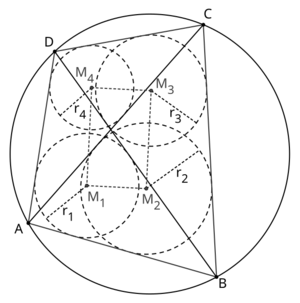Difference between revisions of "Japanese Theorem"
(added deletion request) |
Shalomkeshet (talk | contribs) (Tag: Undo) |
||
| Line 1: | Line 1: | ||
| − | {{ | + | The '''Japanese theorem''' exists for both [[Cyclic_quadrilateral | cyclic quadrilaterals]] and [[Cyclic | cyclic polygons]]. |
| + | |||
| + | ==Japanese theorem for cyclic quadrilaterals== | ||
| + | |||
| + | |||
| + | ====Definition==== | ||
| + | The '''Japanese theorem for cyclic quadrilaterals''' states that for a cyclic quadrilateral <math>ABCD</math> and [[Incenter | incenters]] <math>M_1</math>, <math>M_2</math>, <math>M_3</math>, <math>M_4</math> of triangles <math>\triangle ABD</math>, <math>\triangle ABC</math>, <math>\triangle BCD</math>, <math>\triangle ACD</math> the quadrilateral <math>M_1M_2M_3M_4</math> is a [[Rectangle | rectangle]]. | ||
| + | |||
| + | |||
| + | [[File:japanese_theorem_quadrilaterals.png|300px|thumb|left]] | ||
| + | |||
| + | ====Proof==== | ||
| + | From <math>\triangle ABC</math>, we can see that | ||
| + | |||
| + | <math>\angle BM_2C = 90^{\circ} + \frac{1}{2} \angle CAB</math> | ||
| + | |||
| + | Similarly, from <math>\triangle BCD</math> we have | ||
| + | |||
| + | <math>\angle BM_3C = 90^{\circ} + \frac{1}{2} \angle CDB</math> | ||
| + | |||
| + | Since <math>ABCD</math> is cyclic, therefore <math>\angle CDB = \angle CAB</math>, which means that | ||
| + | |||
| + | <math>\angle BM_2C = \angle BM_3C</math> | ||
| + | |||
| + | From this, it follows that <math>BM_2M_3C</math> is cyclic. This means that | ||
| + | |||
| + | <math>\angle BCM_3 + \angle BM_2M_3 = 180^{\circ}</math> | ||
| + | |||
| + | By symmetry, we can also derive | ||
| + | |||
| + | <math>\angle BAM_1 + \angle BM_2M_1 = 180^{\circ}</math> | ||
| + | |||
| + | Adding these equations up, we get | ||
| + | |||
| + | <math>\angle BAM_1 + \angle BCM_3 + \angle BM_2M_1 + \angle BM_2M_3 = 360^{\circ}</math> | ||
| + | |||
| + | <math>\Rightarrow \angle BM_2M_1 + \angle BM_2M_3 = 360^{\circ} - \angle BAM_1 - \angle BCM_3 = 360^{\circ} - \frac{1}{2} \left(\angle CAB + \angle CDB \right)</math> | ||
| + | |||
| + | Which implies | ||
| + | |||
| + | <math>M_1M_2M_3 = 90^{\circ}</math> | ||
| + | |||
| + | And other angles similarly. | ||
| + | |||
| + | <math>Q.E.D.</math> | ||
| + | |||
| + | |||
| + | ==Japanese theorem for cyclic polygons== | ||
| + | |||
| + | |||
| + | ====Definition==== | ||
| + | The '''Japanese theorem for cyclic polygons''' states that for any triangulated cyclic polygon, the sum of the [[Inradius || inradii]] of the triangles is constant. | ||
Revision as of 13:42, 31 March 2025
The Japanese theorem exists for both cyclic quadrilaterals and cyclic polygons.
Contents
[hide]Japanese theorem for cyclic quadrilaterals
Definition
The Japanese theorem for cyclic quadrilaterals states that for a cyclic quadrilateral ![]() and incenters
and incenters ![]() ,
, ![]() ,
, ![]() ,
, ![]() of triangles
of triangles ![]() ,
, ![]() ,
, ![]() ,
, ![]() the quadrilateral
the quadrilateral ![]() is a rectangle.
is a rectangle.
Proof
From ![]() , we can see that
, we can see that
![]()
Similarly, from ![]() we have
we have
![]()
Since ![]() is cyclic, therefore
is cyclic, therefore ![]() , which means that
, which means that
![]()
From this, it follows that ![]() is cyclic. This means that
is cyclic. This means that
![]()
By symmetry, we can also derive
![]()
Adding these equations up, we get
![]()
![]()
Which implies
![]()
And other angles similarly.
![]()
Japanese theorem for cyclic polygons
Definition
The Japanese theorem for cyclic polygons states that for any triangulated cyclic polygon, the sum of the | inradii of the triangles is constant.










